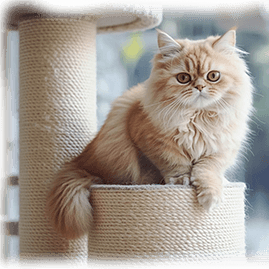Training Bengal Cats: How to Train This Energetic and Intelligent Breed
Bengal cats are known for their wild appearance, intelligence, and high energy levels. While training a Bengal cat can be a rewarding experience, it requires patience, consistency, and a deep understanding of their behavior. They are more trainable than many other cat breeds, often compared to dogs in their willingness to learn commands and tricks. In this post, we’ll explore the best ways to train Bengal cats, from basic commands to behavior management tips.
Understanding Bengal Cat Behavior
Bengals are not your typical lap cats. They are highly active, love to climb, and often exhibit traits like:
- High energy – Bengals need lots of play and exercise. Without proper stimulation, they can become destructive.
- Curiosity – They love to explore and can be quite mischievous, getting into places you might not expect.
- Intelligence – Bengals are quick learners and often enjoy training, especially if it stimulates their mind and body.

Positive Reinforcement for Training
Bengals respond best to positive reinforcement—rewarding good behavior rather than punishing bad behavior. This method strengthens the bond between you and your cat and encourages them to repeat desired actions. Use the following tools:
- Treats – Small, tasty rewards work wonders (Amazon affiliate link). Find treats your Bengal loves and use them to reinforce commands.
- Clicker training – A clicker helps mark the moment they perform the right behavior. This is especially useful for trick training.
- Praise and affection – Along with treats, give your Bengal verbal praise and petting when they follow your commands.
Basic Commands to Start With
Bengal cats, like dogs, can be trained to follow basic commands. Here are a few simple commands to begin with:
- Come – Use their name along with treats and call them. Over time, they will associate their name with the reward and come when called.
- Sit – Hold a treat over their head and gently move it back toward their tail. As their head follows the treat, their rear end will naturally sit down. Reward them when they sit.
- Stay – Once your Bengal has mastered “sit,” hold your hand up and say “stay.” After a short pause, reward them. Gradually increase the time they stay before rewarding them.
Leash Training Your Bengal

Many Bengal owners leash-train their cats, allowing them to safely explore the outdoors. Leash training takes time but can be enjoyable for your Bengal.
- Start Indoors – Begin by letting your Bengal get used to wearing a harness indoors. Start with short periods and offer treats.
- Attach the Leash – Once your Bengal is comfortable with the harness, attach a lightweight leash and let them drag it around the house. Supervise them to avoid any tangles. (Amazon affiliate link)
- Take It Outside – Start with quiet, controlled environments outdoors. Walk slowly and let your cat explore at their own pace. Always use positive reinforcement to make the experience enjoyable.
Behavioral Training and Management

Bengals, with their high energy and intelligence, can sometimes exhibit challenging behaviors. Here’s how to manage common issues:
- Destructive Behavior – If your Bengal scratches furniture or chews on items, they likely need more physical and mental stimulation. Provide plenty of scratching posts, interactive toys, and climbing structures. (Amazon affiliate link)
- Aggression – Bengals can become aggressive if they’re bored or frustrated. Make sure they have outlets for their energy, and redirect any aggressive behavior to toys rather than your hands or feet.
- Climbing – Bengals are natural climbers. Instead of preventing this behavior, provide them with cat trees or shelves to climb. This fulfills their need to explore vertical spaces.
Mental Stimulation
Because Bengals are so smart, they require mental stimulation to prevent boredom. Here are ways to keep their minds sharp:
- Puzzle Toys – Toys that release treats when solved can keep your Bengal engaged for hours. (Amazon affiliate link)
- Interactive Play – Games that mimic hunting, like feather toys, are perfect for Bengals. Make time for regular play sessions.
- Teaching Tricks – Bengals can learn more complex tricks like “high five” or “roll over.” Use positive reinforcement and break down the trick into small steps for easier learning.

Consistency is Key
As with any cat, consistency in training is crucial. Stick to a regular training schedule and ensure all family members use the same commands and rules. This will prevent confusion and help your Bengal learn more quickly.
Litter Training
Bengals, like most cats, are naturally inclined to use a litter box (Amazon affiliate link). However, there are some tips to ensure success:
- Clean the Litter Box Frequently – Bengals can be particular about cleanliness, so make sure their litter box is clean and odor-free.
- Location Matters – Place the litter box in a quiet, accessible area where your Bengal feels comfortable using it.
Reading materials: “The Complete Guide to Bengal Cats: Training, Nutrition, Health Care, Mental Stimulation, Socialization, Grooming, and Loving Your New Bengal Cat” (Amazon affiliate link) by Tarah Schwartz.
Patience and Playfulness
Training a Bengal cat can be both challenging and rewarding. Remember, patience is key—Bengals are intelligent but can also be independent and willful. Keep training sessions short, fun, and filled with rewards. Over time, you’ll see your Bengal not only follow commands but also enjoy the process.
Affiliate Disclosure
This post may contain affiliate links, which means I earn from purchases made through links. Please see the privacy policy page for more details.





